Sacred Locations Noted in The Qur'an
The locations which are noted in the Qur'an are those where the prophets lived through history (such as Mount Tur and the valley of Tuwa), or the cities where Prophet Muhammad (may God bless him and grant him peace) lived and taught about religion to the people.
Sacred places are a reminder of the struggles between prophets and their followers against unbelievers. They also remind us of the extraordinary patience and decisiveness of these blessed people in God's way. For this reason, the sacred sites are a cause of increased excitement and enthusiasm among believers.
Believers feel a special spiritual bond with these lands and sites. They want to get to know these lands, which carry the valuable memories of the prophets. In the following pages, we will focus on some of these sacred sites.
God has made the Kaaba, the Sacred House, a special institution for humanity, and also the sacred months and the sacrificial animals and the ritual garlands. That is so you will know that God knows what is in the heavens and in the Earth and that God has knowledge of all things. (Qur'an, 5:97)
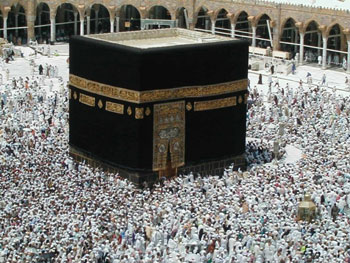
The Hajj (pilgrimage) is a duty commanded to all Muslims by God in the Qur'an. This most important task of the Hajj takes place with the circling of the Kaaba (the House).
Today, the Kaaba is found in the courtyard of the Masjid al-Haram (the Sacred Mosque). It was built according to God's command by Prophet Abraham and his son, Prophet Ishmael (peace be upon them).
And We located the position of the House for Abraham... (Qur'an, 22:26)
Just as it is explained in this verse, Prophet Abraham (pbuh) built the Kaaba in the place and in the way God commanded him to.
The Kaaba is a site where people can come together and worship God. God specified that the Kaaba would be a clean and safe site where the believers would worship.
The careful protection of the Kaaba is one of the most important duties of Muslims. Our Lord, Who commanded Prophet Abraham (pbuh) to keep the Kaaba clean and safe for believers, also made it clear in the Qur'an that only believers are to protect it. In a verse from the Qur'an, God reveals that the true protectors and guardians of the Kaaba are those who believe:
... Only people who guard against evil can be its guardians. But most of them do not know that. (Qur'an, 8:34)
Another important aspect of the Kaaba within the Islamic world is that it is the direction of prayer for Muslims. Muslims all over the world, in prayer five times a day, worship in the direction of the Kaaba.
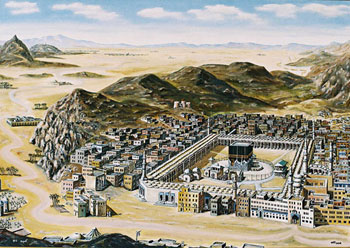
The first house established for humanity was that at Bakka, a place of blessing and a guidance for all beings. (Qur'an, 3:96)
And when Abraham built the foundations of the House with Ishmael: "Our Lord, accept this from us! You are the All-Hearing, the All-Knowing." (Qur'an, 2:127)
And We located the position of the House for Abraham: "Do not associate anything with Me and purify My House for those who circle it, and those who stand and bow and prostrate." (Qur'an, 22:26)
Announce the pilgrimage to humanity. They will come to you on foot and on every sort of lean animal, coming by every distant road. (Qur'an, 22:27)
... A mosque founded on performing one's duty from the first day has a greater right for you to stand in it. In it there are men who love to purify themselves. God loves those who purify themselves. (Qur'an, 9:108)
Maqam Ibrahim (Station of Abraham)
On the east side of the Kaaba, about two meters high, one meter wide, there is a rectangular structure covered in glass on its top part and marble on the bottom. This structure protects a stone that Prophet Abraham (pbuh) stepped on while building the Kaaba. Islamic and historical sources accept this as the point mentioned in the Qur'an as "the Maqam of Abraham."
The stone, which is called "Hajar al-Aswad" is traditionally accepted as the starting point for the circling of the Kaaba. According to stories, this stone was put in its place by Prophet Abraham (pbuh). "Hajar al-Aswad" means "The Black Stone."
Safa and Marwa are among the landmarks of God, so anyone who goes on pilgrimage to the House or does the pious visit incurs no wrong in going back and forth between them... (Qur'an, 2:158)
This stone, which is found on the east side of the Kaaba, is about one and a half meters high. It is yellowish black, and oval shaped. There are red spots on it. The sides are covered in silver. People making the Hajj begin their circulation of the Kaaba at the Hajar al-Aswad. While circling the Kaaba, pilgrims face this stone, lifting their hands in praise.
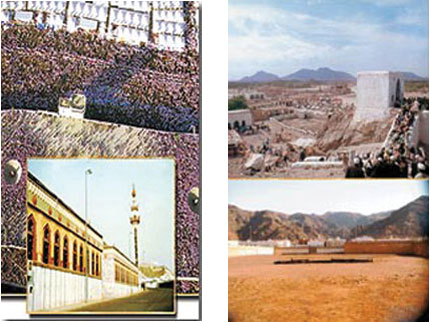 | Left: (Above)The top of Mina
Right: In these pictures, you can see the places of worship called the Sab'ah Masajid (Seven Masjids), built on the spot where the Battle of Khandaq (Battle of the Trench) took place. According to historical sources, the masjid on the right was used by our Prophet (may God bless him and grant him peace). Below is the Uhud cemetery. |
Safa and Marwa are two hills to the east of the Kaaba. Mount Safa is about 15 meters higher than the Haram area, while Mount Marwa is about 8 meters in height. There are about 420 meters in between the two hills. The area in between them is called "Masa," which is adjacent to the Masjid al-Haram. In pictures, you can see pilgrims performing Sa'y (walking between Safa and Marwa).
Left: A different view of the Masjid al-Haram
Right: Day and night views of the Masjid al-Nabawi | 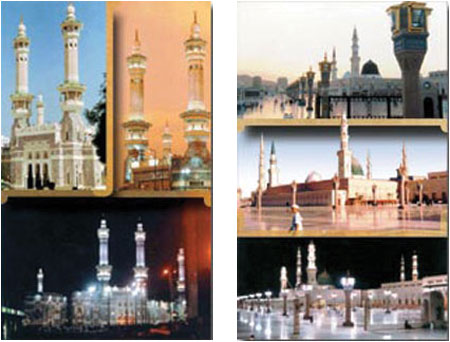 |
Arafat is a large and flat plain of twenty-four square kilometers which lies to the north of Mecca. It is outside of Haram. The name "Arafat" is the plural of "arafa," and comes from the root of the words "irfan" (insight) and "marifa" (knowledge). It also means mountain. This is how Arafat is mentioned in the Qur'an:
There is nothing wrong in seeking bounty from your Lord. When you pour down from Arafat, remember God at the Sacred Landmark. Remember Him because He has guided you, even though before this you were astray. Then press on from where the people press on and ask God's forgiveness. God is Ever-Forgiving, Most Merciful. (Qur'an, 2:198-199)
Mina is the name of the place between Mecca and Mash'ar al-Haram. During Hajj, pilgrims also visit Mina. Some of the important rituals of the Hajj take place here:
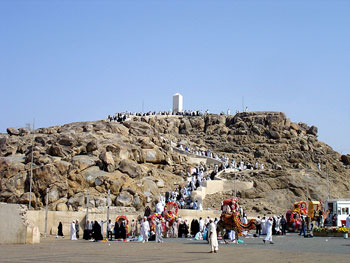 |
Pictures of Arafat and Mount Rahmat during the Hajj. |
Remember God on the designated days. Those who hurry on [to leave Mina] in two days have done no wrong, and those who stay another day have done no wrong – those of them who guard against evil. So fear [and respect] God. And know that you will be gathered back to Him. (Qur'an, 2:203)
It is not for the idolaters to maintain the mosques of God, bearing witness against themselves of their disbelief. They are the ones whose actions will come to nothing. They will be in the fire timelessly, for ever. (Qur'an, 9:17)
The mosques of God should only be maintained by those who believe in God and the Last Day and perform prayer and give the alms, and fear no one but God. They are the ones most likely to be guided. (Qur'an, 9:18)
Glory be to Him Who took His servant on a journey by night from the Sacred Mosque [Masjid al-Haram] to the Further Mosque [Masjid al-Aqsa], whose surroundings We have blessed, in order to show him some of Our signs. He is the All-Hearing, the All-Seeing. (Qur'an, 17:1)
Due to the fact that Masjid al-Aqsa was the first direction of prayer for Muslims, it carries an important distinction. It is accepted that Masjid al-Aqsa is the second mosque ever built, the first being the Kaaba.
In 638 AD, after Jerusalem was conquered during the period of the Caliph Omar, Masjid al-Aqsa was built at the site of Bayt al-Maqdis. The fact that Caliph Omar accepted this as a place of worship is also another reason it is important for Muslims. Masjid al-Aqsa was later constructed in its new structure during the rule of a later caliph, Abd al-Malik ibn Marwan.
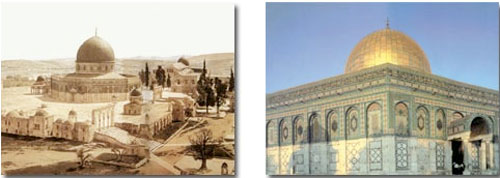 | |
An 1890 view of Qubbat al-Sakhra and Masjid al-Aqsa | The Mosque of Omar |
Qubbat al-Sakhra (Dome of the Rock) is also known as the Mosque of Omar, but it was not built as a mosque. Inside the structure, there is a stone believed to have been stepped on by Prophet Muhammad (may God bless him and grant him peace) during his ascension to heaven; the stone is considered sacred. The word "sakhra" means a "piece of rock," and so Qubbat al-Sakhra means a dome built on rock. To the east of the rock in the structure, there is a long cupboard which contains what is believed to be hairs from Prophet Muhammad's (may God bless him and grant him peace) sacred beard.
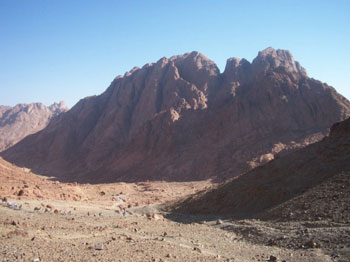 |
A view of Mount Sinai |
Say: "My Lord has commanded justice. Stand and face Him in every mosque and call on Him, making your religion sincerely His. As He originated you, so you will return." (Qur'an, 7:29)
And [I swear by] Mount Sinai and this safe land. (Qur'an, 95:2-3)
He picks out for His mercy whoever He wills. God's favor is indeed immense. (Qur'an, 3:74)
